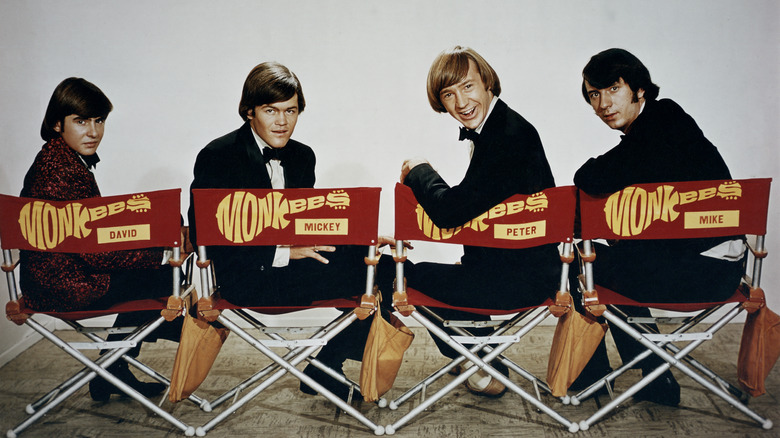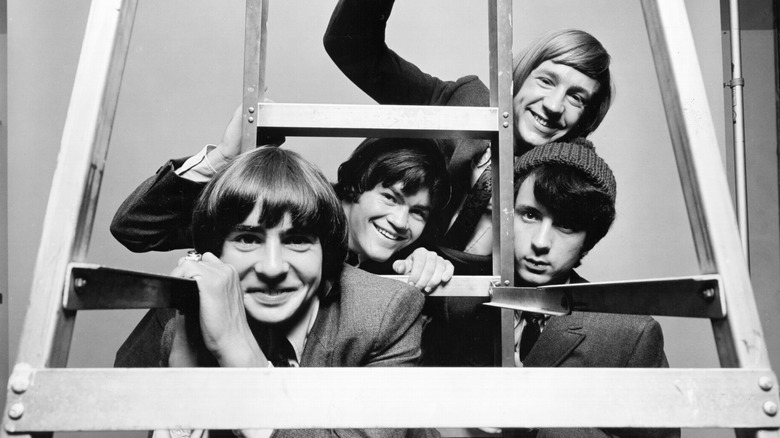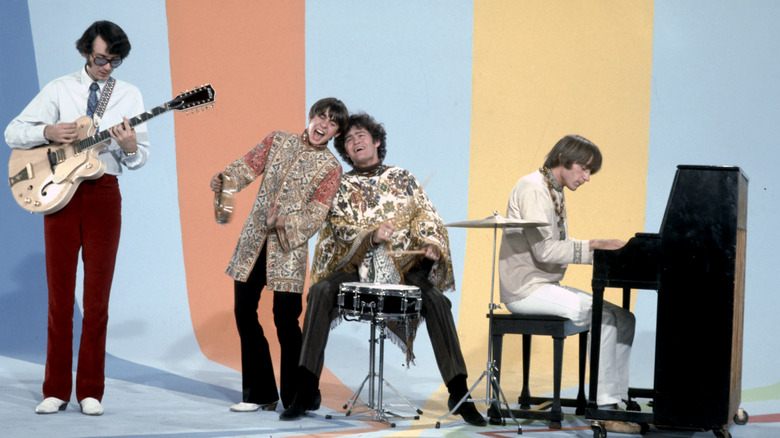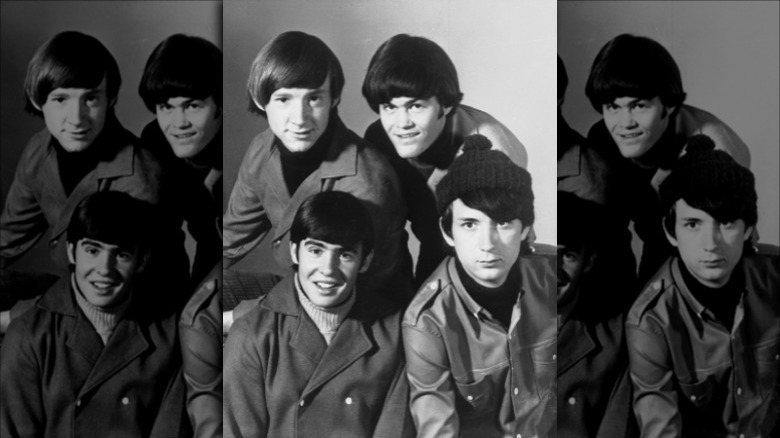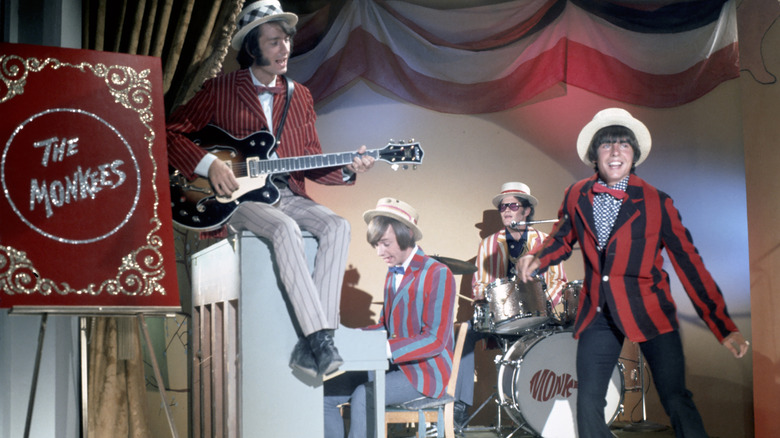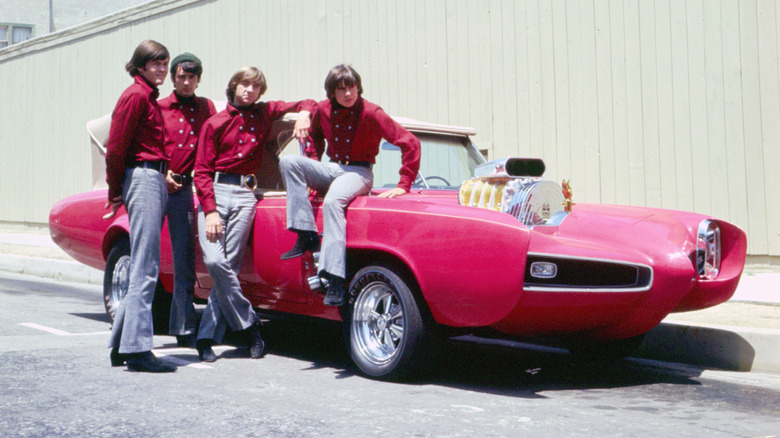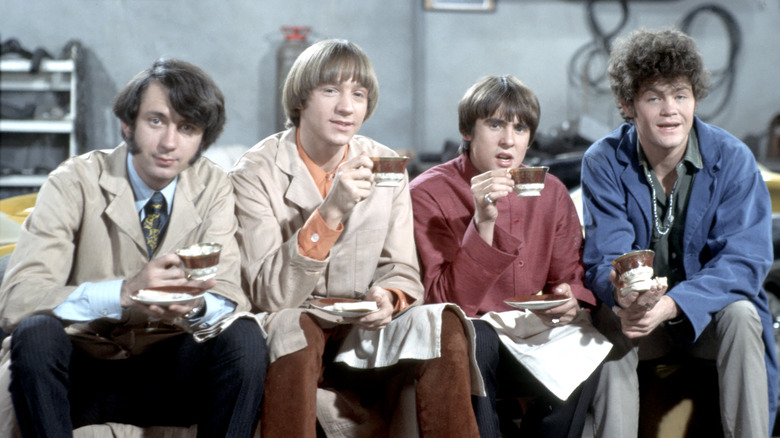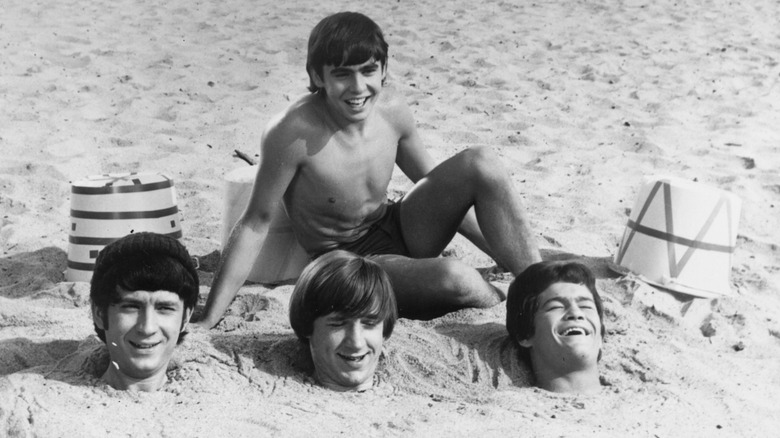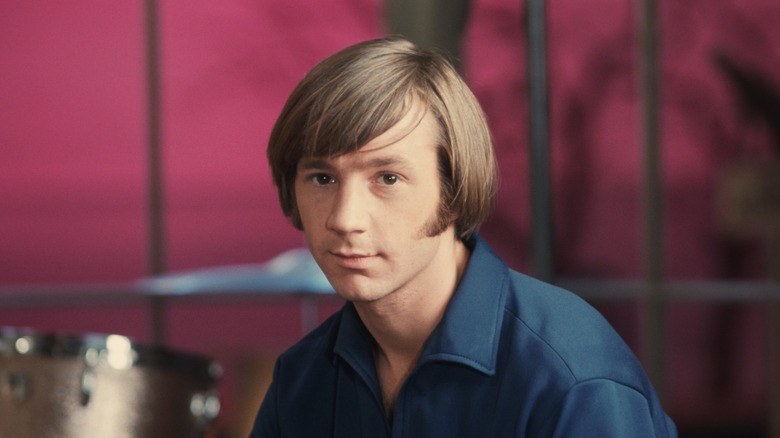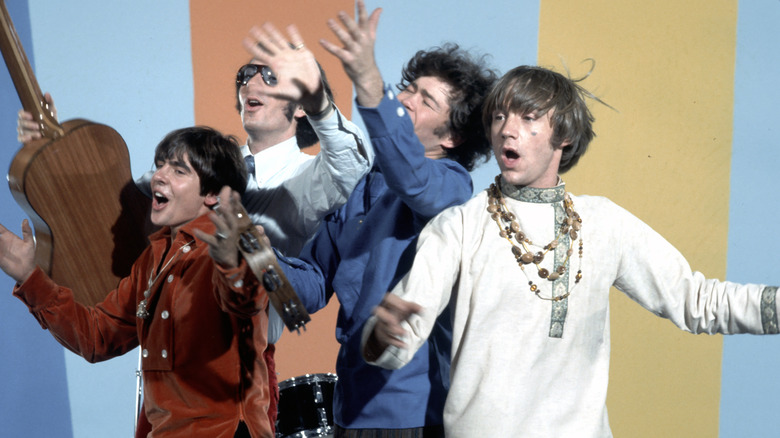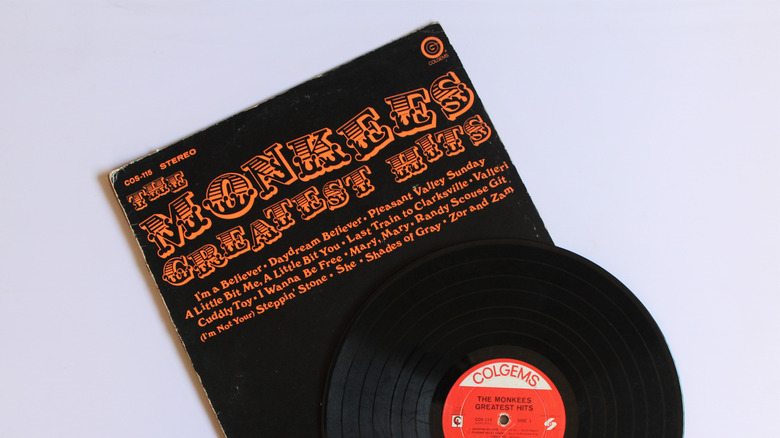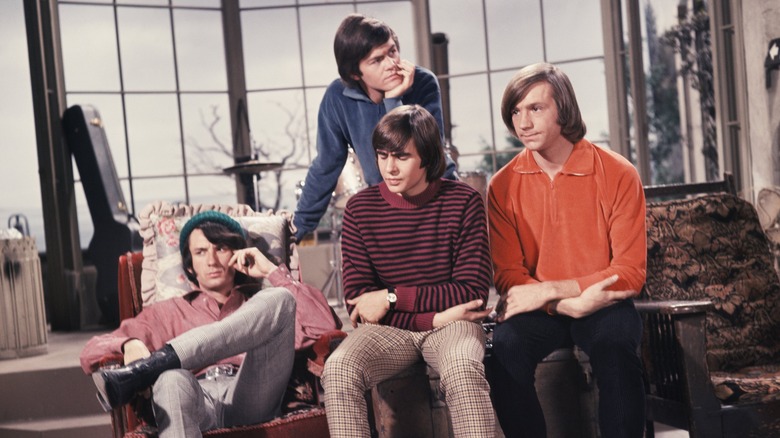The Untold Truth Of The Monkees TV Show
The 1960s was a weird time. But like many weird times in history, it was also a time of creative revolution, as the constraints of a prior generation were stripped away. As silly as some of the fashions and attitudes might seem to people today, the 1960s saw new technologies and new artistic paradigms transform just about every medium, including television. And one of the most important television shows from the decade is "The Monkees."
If you think "The Monkees" was just a silly show about a fake rock band cynically designed to profit off of Beatlemania ... you would not be entirely wrong. But somehow the show achieved real, lasting cultural impact — so much so that we're still discussing both the show and the band today, decades after it went off the air. In just two seasons, "The Monkees" managed to have an outsized impact on popular culture.
But that impact is often hidden behind the false idea that the Monkees was a fake band that had a brief moment of popularity. The fact is, the band was actually very real (the Monkees released 13 albums!) and remains incredibly popular today. Here's the untold truth of "The Monkees" TV show.
The band was assembled professionally
One part of the "fake band" story is absolutely true: The Monkees was not a real band that happened to get a TV deal. Rather, Biography explains that producer Bob Rafelson had wanted to create a show based on his own experiences as a musician. He sold the concept in 1965, and needed a rock band that could actually perform to make the show work. According to Society of Rock, the very real band The Lovin' Spoonful were briefly considered, but in the end the legal ramifications of using an existing band seemed too difficult.
Rafelson placed an advertisement looking for "folk & roll musicians singers" in some trade magazines. About 437 people responded to the ad, including future legend Stephen Stills, who didn't get the gig (via Forbes). The only future Monkee who showed up for that initial audition was Micheal Nesmith.
The four men who were eventually cast — Micky Dolenz, Pete Tork, Mike Nesmith, and Davy Jones — were relatively unknown, but they were all professionals. Nesmith and Tork were both accomplished musicians and performers (in fact, Stills recommended his friend Tork to Rafelson). Dolenz had already appeared on television a few times in small roles, including in episodes of "Playhouse 90" and "Peyton Place." And the Los Angeles Times reports that Jones had received a Tony nomination in 1963 for his performance in "Oliver!"
The Monkees gelled as a band fast
Although the four guys selected to be the Monkees all had performing and musical experience, they'd never played together before forming the band for the show. Biography explains that producer Bob Rafelson hired veteran music producer Don Kirshner to whip them into shape. This included weeks of rehearsals, acting classes, and filming a pilot.
All that work paid off. Best Classic Bands notes that the original advertisement seeking musicians for the show appeared on September 8, 1965. Taping for the show began on May 31, 1966, and the Monkees' debut single "Last Train to Clarkesville" was released on September 3, 1966. The show premiered a week later, on September 12, 1966, and the band's debut album, "The Monkees," dropped on October 8. Both the single and the album hit No. 1 on October 29, with the album actually knocking "Revolver" by the Beatles out of the top spot. However you look at it, that's a masterful job of marketing and promotion. But none of it would have happened if the band hadn't gelled immediately.
Yahoo! News reports that "The Monkees" remained the No. 1 album in the Billboard 200 album chart until it was knocked out of the top spot by "More of the Monkees," the group's second album, which included the band's all-time classic "I'm a Believer," written by Neil Diamond. In other words, the Monkees were a legit phenomenon.
The Monkees were explicitly based on the Beatles
According to Biography, the idea behind "The Monkees" TV show predated the Beatles. Bob Rafelson was a musician, and he'd been floating the idea of a TV show based on his experiences since at least 1963. But no one was interested until Beatlemania and the success of the Fab Four's movie "A Hard Day's Night." So it's not too surprising that the personas of the Monkees were explicitly based on the Beatles.
The Chicago Tribune explains that part of Beatlemania involved each of the Fab Four being given simple identities: Paul McCartney was the cute one, John Lennon was the smart one, George Harrison was the quiet one, and Ringo was the clown. Closer Weekly reports that the four guys cast in "The Monkees" were explicitly given similar roles to play: Davy Jones was the cute one, Micky Dolenz was the funny one, Mike Nesmith was the smart one, and Peter Tork got the thankless role of the clown. According to the AV Club, Tork fell into that role easily because he'd perfected a "dummy" persona while performing in New York City's Greenwich Village folk music scene.
The way the Monkees were linked so explicitly to the Beatles earned them one of their earliest and most dismissive nicknames: the Prefab Four.
The Monkees pilot tanked
Considering how incredibly successful "The Monkees" ultimately was, it's easily forgotten that the first version of the show's pilot was a disaster. According to Woman's World, the original pilot was one of the lowest-rated pilots presented up to that time. In his autobiography, "I'm a Believer: My Life of Monkees, Music, and Madness," drummer Micky Dolenz says that all the TV networks turned down the pilot. That could have been the end of the story, but producer Bob Rafelson — who had been trying to get the concept off the ground since 1963 — insisted on re-editing the pilot to try to save the day. Changes included cutting out the character of the band's manager, removing some title cards, and introducing raw footage from the cast's screen tests.
REBEAT explains that the end result — which actually aired as episode 10 of the first season — is pretty ragged. The story, which involves Davy falling in love with a teenage girl when the band is hired to play her sweet 16 party, makes little sense in its re-edited version. And many of the jokes were butchered, leaving behind punch lines without any sort of setup or context.
The changes clicked with audiences, however. Biography confirms that the new version was a hit with test groups, and NBC picked up the show in early 1966.
The Monkees TV show was groundbreaking
It's easy to dismiss "The Monkees" as a silly 1960s show exploiting the popularity of the Beatles, but in fact it was truly a groundbreaking show in an artistic sense. The Saturday Evening Post explains that "The Monkees" was on the cutting edge of what you could do on television at the time. It purposefully introduced avant-garde concepts like improvisation, jump cuts, and meta-referential humor that broke the fourth wall, and explicitly noted that it was a fictional TV show.
It's hard for modern audiences to understand how ground-breaking "The Monkees" was, but considering that the top-rated sitcom on TV in 1966 was "folksy" sitcom "The Andy Griffith Show" gives you some idea of how different "The Monkees" really was. The AV Club reports that the show was one of the first to use postmodern techniques, like Micky Dolenz walking off to talk to the writers directly, or Davy Jones stopping in the middle of a scene to ask for a second take.
In "Why the Monkees Matter: Teenagers, Television and American Pop Culture," author Roseanne Welch notes that "The Monkees" used a metatextual approach to challenge other limitations. In one episode, Peter Tork makes a deal with the Devil, and the band discusses going to hell. But each time they say "hell," it's bleeped out due to television censorship, leading to Micky saying "You know what's even more scary? You can't say 'hell' on television," with the word "hell" still bleeped out.
The Monkees show pioneered modern music videos
The Monkees didn't invent the music video — there are plenty of examples of musical short films going back decades. And the TV show didn't even pioneer the fast editing and energy that we associate with modern music videos — the Beatles kind of did that with "A Hard Days Night." But, as explained by The Diversity of Classic Rock, the musical segments on "The Monkees" differed from more traditional TV shows in that they were presented as separate from the narrative — essentially as music videos dropped in the middle of the story.
REBEAT explains that these energetic scenes were called "romps," and they were a big part of the show's popularity, as they were different from anything else on television. The AV Club reports that these proto music video sequences influenced the Monkees themselves, and Michael Nesmith in particular.
Nesmith inherited a large fortune from his mother (as CNBC explains, Bette Nesmith Graham invented Liquid Paper correction fluid), and used it to "help kick off the music-video industry." According to the Chicago Tribune, Nesmith created some of the first official music videos, and came up with the idea for a full-time music video television channel. That's right, he essentially invented MTV.
The show flipped the generation script
As the AV Club notes, when "The Monkees" debuted in 1966 there was something extremely unusual about the show that today's audiences might not notice: There was no "adult" character to offer the band moral guidance and advice. As guitarist Peter Tork told the Concord Monitor, this was really unheard of — every comedy before had a "senior adult figure," but "The Monkees" presented a group of young people figuring stuff out all on their own. As the generation gap widened in the 1960s, this was a pretty notable artistic decision.
It was also a step that almost didn't happen. As Micky Dolenz explains in his memoir, the original pilot for the show did have a senior adult figure to offer guidance to the band — their manager. Envisioned as a "manager knows best" character, there's little doubt his presence would have completely changed the tone of the show.
Luckily, the original pilot for the show failed and had to be re-envisioned. Producer Bob Rafelson re-edited the pilot and cut the manager character out completely. As reported by Monkees Live Almanac, the manager character — Rudy Gunther — only appeared in the pilot (which was aired as episode 10 of the first season), where he got the band a gig playing a sweet 16 party, and he's never referenced again.
The Monkees used Three Stooges props
"The Monkees" is a comedy with distinct slapstick roots, so it makes sense that there are connections to the Three Stooges. The interactions between the band members often echoes the way Larry, Moe, and Curly would rapid fire jokes and perform physical comedy.
Forbes explains that when Michael Nesmith, Micky Dolenz, Peter Tork, and Davy Jones were hired, they had to undergo a lot of training in improvisation to make the loose, avant-garde scripts for the show work properly. According to Dolenz, the producers made the cast watch films by the Three Stooges in order to learn those skills, and author Jonathan Etter notes that director Irving Lippman, who directed 56 of the 58 episodes of "The Monkees," had directed several Three Stooges films before working on the show.
Womans World reports that the show repurposed a lot of the sets and props that the Three Stooges had used in their films, including a pair of pajamas worn by both Curly Howard and Peter Tork. "The Monkees" would have been a different show if the Three Stooges hadn't existed.
The show always came in short
As author Jake Austen notes in "TV-a-Go-Go: Rock on TV from American Bandstand to American Idol," "The Monkees" was a scripted show, but the scripts were very loose. Television Academy reports that the "romps" in each episode and a lot of the dialogue were improvised by the cast.
That improv spirit gave the show its zany energy and contributed to its rule-breaking success. But it had a downside. As The 60s Official Site explains, the lack of a strict script meant timing out the episodes was impossible, and as a result many of the episodes came in short. Due to the meta nature of much of the show's humor, being "a minute short as usual" became a recurring joke on the show.
According to author Rosanne Welch, the producers solved this problem by adding interviews with the cast and crew to the end of short episodes. This may have started as an easy way to extend an episode, but it quickly became a popular aspect of the show, and is another example of "The Monkees" breaking new ground by further dissolving the line between actor and character.
The Monkees show won two Emmy Awards
Even those who have fond memories of "The Monkees" sometimes fall into the trap of thinking of it as a slight comedy that rode the coattails of Beatlemania. But the show is recognized as introducing a long list of avant-garde film techniques to the American television audience. And such appreciation for the show isn't new — even back in the '60s, people recognized that "The Monkees" was a really great show.
In fact, as reported by Woman's World, the show actually won two Emmy Awards during its run, picking up one for outstanding comedy series and a second for outstanding directorial achievement in comedy (for the work of director James Frawley on the episode "Royal Flush") in 1967.
Television Academy explains that the show was recognized for its innovative approach to the staid sitcom format. And, as noted by Closer Weekly, that's more impressive than it seems. "The Monkees" beat out classic shows like "Get Smart" and "Hogan's Heroes" to get those Emmys. To put the win in perspective, other sitcoms that have won an Emmy for outstanding comedy series include "All in The Family," "M*A*S*H," "Seinfeld," "The Office," and "Fleabag."
In "Total Control: The Michael Nesmith Story," author Randi L. Massingill reports that "The Monkees" taking two Emmy's was a bit of a shock; "The Dick Van Dyke Show" had just ended after dominating the award for years, and everyone expected an established show with better ratings to win.
People were shocked The Monkees wasn't a real band
The Monkees were hugely successful and popular during the first season of their show, but much of the viewing public assumed, incorrectly, that they were a real band that wrote and performed their own music.
Yahoo! News explains that the Monkees weren't talentless hacks — Mike Nesmith and Peter Tork had professional experience as musicians, Davy Jones had been nominated for a Tony Award, and Nesmith had even written a hit song, "Different Drum" (which the Stone Poneys Featuring Linda Ronstadt took to No. 13 on the charts in 1968). But they'd never played in a band together, and Micky Dolenz had never played drums before.
A killer group of songwriters wrote most of the material on the Monkees' first two albums, including Carole King, Neil Sedaka, Paul Williams, and Harry Nilsson, and some of the best session musicians in the world recorded the music for their albums (including, as reported by the New Yorker, the legendary Wrecking Crew).
The Hollywood Reporter explains that when the band's lack of involvement in their early songs became widely known, there was a backlash. Closer Weekly reports that the band began taking on more and more playing and songwriting duties, and toured extensively to practice.
However, even with their improved musical abilities, a third season of "The Monkees" never happened. According to Woman's World, the show had "begun recycling old scripts," which the band didn't like. They reportedly wanted to create an hour-long variety show for the third season, but NBC wasn't on board. When the band refused to do a third season as a sitcom, it brought "The Monkees" to an end.
The Monkees lived on in syndication
For a show that lasted just two seasons in the late 1960s, "The Monkees" remains pretty prominent in pop culture. The reason for that is simple: syndication and MTV.
Closer Weekly reports that "The Monkees" went into syndication on CBS in 1969, where it ran on Saturday mornings. An entire new generation of kids was exposed to its charms as they ate their cereal. When the show went into general syndication in 1975, that audience expanded to include the entire country.
Then, in 1986, MTV began airing old episodes of "The Monkees" and something unexpected happened: Vulture reports that the reruns were among MTV's highest-rated programs. This sparked a second wave of "Monkeemania." Rolling Stone reports that four of the band's old albums reentered the charts, the band reunited for a successful tour, and eventually began recording new music.
Perpetual reruns targeting new young audiences that would appreciate the band's lighthearted humor and ear-candy music kept the Monkees going for decades.
